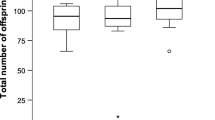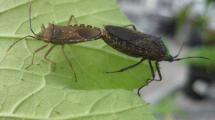Abstract
Current models on protandry in butterflies assume that females mate only once, yet for many species this assumption is not realistic. In this paper a model is formulated to study how polyandry, i.e. repeated mating of females, affects protandry. Moreover, the model is elaborated to describe the probability distribution of the number of matings per female. Field data on this distribution are well described by the model, which supports the use of the law of mass action to describe the encounter rate between males and females. Finally, a weight factor is derived, taking into account the decline in oviposition rate with age, as well as the chance that a female is remated. In comparison with the situation that all matings contribute equally to a male's reproductive success, the application of the weight factor enhances protandry. This suggests that mate competition is not the sole cause of protandry.
Similar content being viewed by others
Literature
Boggs, C. L. 1986. Reproductive strategies of female butterflies: variation in and constraints on fecundity.Ecol. Entomol 11, 7–15.
Bulmer, M. G. 1983. Models for the evolution of protandry in insects.Theor. Pop. Biol. 23, 314–322.
Burden, R. L., and J. D. Faires. 1985.Numerical Analysis. Boston: Prindle, Weber and Schmidt.
Burns, J. M. 1968. Mating frequency in natural populations of skippers and butterflies as determined by spermatophore counts.Proc. natn. Acad. Sci. USA 61, 852–859.
Drummond III, B. A. 1984. Multiple mating and sperm competition in the Lepidoptera. InSperm Competition and the Evolution of Animal Mating Systems R. L. Smith (Ed), pp. 291–370. London: Academic Press.
Ehrlich, A. H., and P. R. Ehrlich. 1978. Reproductive strategies in the butterflies: I. Mating frequency, plugging, and egg number.J. Kans. Entomol. Soc. 51, 666–697.
Fagerström, T. and C. Wiklund. 1982. Why do males emerge before females? Protandry as a mating strategy in male and female butterflies.Oecologia 52, 164–166.
Forsberg, J., and C. Wiklund. 1989. Mating in the afternoon: Time-saving in courtship and remating by females of a polyandrous butterflyPieris napi L.Behav. Ecol. Sociobiol. 25, 349–356.
Gilbert, L. E.. 1976. Postmating female odor inHeliconius butterflies: a male-contributed antiaphrodisiac.Science 193, 419–420.
Iwasa, Y., F. J. Odendaal, D. D. Murphy, P. R. Ehrlich, and A. E. Launer. 1983. Emergence patterns in male butterflies: a hypothesis and a test.Theor. Pop. Biol. 23, 363–379.
Nylin, S. 1989. Effects of changing photoperiods in the life cycle regulation of the comma butterfly,Polygonia c-album (Nymphalidae).Ecol. Entomol. 14, 209–218.
Nylin, S. 1992. Seasonal plasticity in life-history traits: growth and development inPolygonia c-album (Lepidoptera: Nymphalidae).Biol. J. Linn. Soc., in press.
Pliske, T. E. 1973. Factors affecting mating frequencies in some new world butterflies and skippers.Ann. Entomol. Soc. Am. 66, 164–169.
Scott, J. A. 1973. Lifespan of butterflies.J. Res. Lepidop. 12, 225–230.
Svärd, L. and C. Wiklund. 1989. Mass and production rate of ejaculates in relation to monandry/polyandry in butterflies.Behav. Ecol. Sociobiol. 24, 395–402.
Wickman, P-O. 1986. Courtship solicitation by females of the small heath butterfly,Coenonympha pamphilus (L.) (Lepidoptera: Satyridae) and their behaviour in relation to male territories before and after copulation.Anim. Behav. 34, 153–157.
Wickman, P-O, and B. Karlsson 1987. Changes in egg colour, egg weight and oviposition rate with the number of eggs laid by wild females of the small heath butterfly,Coenonympha pamphilus.Ecol. Entomol. 12, 109–114.
Wiklund, C. 1982. Behavioural shift from courtship solicitation to mate avoidance in female ringlet butterflies (Aphantopus hyperanthus) after copulation.Anim. Behav. 30, 790–793.
Wiklund, C., and T. Fagerström 1977. Why do males emerge before females? A hypothesis to explain the incidence of protandry in butterflies.Oecologia 31, 153–158.
Wiklund, C. and J. Forsberg. 1985. Courtship and male discrimination between virgin and mated females in the orange tip butterflyAntocharis cardamines.Anim. Behav. 34, 328–332.
Wiklund, C. and J. Forsberg. 1991. Sexual size dimorphism in relation to female polygamy and protandry in butterflies: a comparative study of Swedish Pieridae and Satyridae.Oikos 60, 373–381.
Zonneveld, C. 1991. Estimating death rates from transect counts.Ecol. Entomol. 16, 115–121.
Zonneveld, C. and J. A. J. Metz. 1991. Models on butterfly protandry: virgin females are at risk to die.Theor. Pop. Biol. 40, 308–321.
Author information
Authors and Affiliations
Rights and permissions
About this article
Cite this article
Zonneveld, C. Polyandry and protandry in butterflies. Bltn Mathcal Biology 54, 957–976 (1992). https://doi.org/10.1007/BF02460661
Received:
Revised:
Issue Date:
DOI: https://doi.org/10.1007/BF02460661




